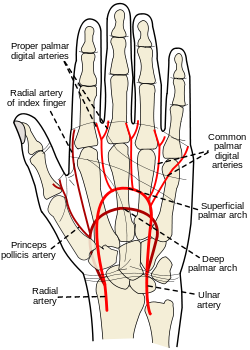Allen's test
Allen's Test
Allen's Test, also known as the Allen Test, is a vital medical sign used in the physical examination of arterial blood flow to the hands. This test plays a crucial role in assessing the integrity of the arterial supply to the hand and is named in honor of Dr. Edgar Van Nuys Allen, who originally described the test in 1929. Over time, modifications and improvements to the test have been made, and a widely accepted alternative method, known as the Modified Allen's Test or Modified Allen Test, has become the standard in contemporary medical practice.
Purpose
The primary purpose of Allen's Test is to evaluate the patency and adequacy of blood flow through the radial and ulnar arteries in the hand. This assessment is particularly important before performing procedures that may compromise arterial circulation, such as arterial line placement, cardiac catheterization, or hand surgeries. By assessing both the radial and ulnar arteries, healthcare professionals can determine if one of these arteries is compromised, allowing them to choose the optimal site for arterial access.
Procedure
The traditional Allen's Test involves the following steps:
- 1. The patient is seated comfortably, and their hands are elevated to ensure venous drainage.
- 2. The examiner compresses both the radial and ulnar arteries in the patient's wrist, effectively blocking blood flow to the hand.
- 3. The patient is then asked to make a fist several times to remove any remaining oxygenated blood from the hand.
- 4. The examiner releases pressure on one of the arteries (typically the ulnar artery), while continuing to block the other (radial artery).
- 5. The patient is instructed to open their hand fully, which should now appear blanched or pale.
- 6. The examiner observes the speed at which normal color and perfusion return to the hand. If this occurs within approximately 5-15 seconds, it is considered a positive Allen's Test, indicating adequate collateral circulation.
Modified Allen's Test
The Modified Allen's Test is an updated version of the original test, offering greater reliability and precision. In this method, the examiner only compresses the radial artery while leaving the ulnar artery open. The rest of the procedure remains the same. This modification has almost universally replaced the original method in modern medical practice due to its improved accuracy and patient comfort.
Clinical Significance
A positive Allen's Test, whether using the traditional or modified method, suggests that there is adequate collateral circulation in the hand. This means that occluding one of the major arteries (radial or ulnar) will not significantly compromise blood supply to the hand. In contrast, a negative Allen's Test indicates insufficient collateral circulation, making the occluded artery an unsuitable site for medical procedures.
References
See Also
Transform your life with W8MD's budget GLP-1 injections from $125.
W8MD offers a medical weight loss program to lose weight in Philadelphia. Our physician-supervised medical weight loss provides:
- Most insurances accepted or discounted self-pay rates. We will obtain insurance prior authorizations if needed.
- Generic GLP1 weight loss injections from $125 for the starting dose.
- Also offer prescription weight loss medications including Phentermine, Qsymia, Diethylpropion, Contrave etc.
NYC weight loss doctor appointments
Start your NYC weight loss journey today at our NYC medical weight loss and Philadelphia medical weight loss clinics.
- Call 718-946-5500 to lose weight in NYC or for medical weight loss in Philadelphia 215-676-2334.
- Tags:NYC medical weight loss, Philadelphia lose weight Zepbound NYC, Budget GLP1 weight loss injections, Wegovy Philadelphia, Wegovy NYC, Philadelphia medical weight loss, Brookly weight loss and Wegovy NYC
|
WikiMD's Wellness Encyclopedia |
| Let Food Be Thy Medicine Medicine Thy Food - Hippocrates |
Medical Disclaimer: WikiMD is not a substitute for professional medical advice. The information on WikiMD is provided as an information resource only, may be incorrect, outdated or misleading, and is not to be used or relied on for any diagnostic or treatment purposes. Please consult your health care provider before making any healthcare decisions or for guidance about a specific medical condition. WikiMD expressly disclaims responsibility, and shall have no liability, for any damages, loss, injury, or liability whatsoever suffered as a result of your reliance on the information contained in this site. By visiting this site you agree to the foregoing terms and conditions, which may from time to time be changed or supplemented by WikiMD. If you do not agree to the foregoing terms and conditions, you should not enter or use this site. See full disclaimer.
Credits:Most images are courtesy of Wikimedia commons, and templates, categories Wikipedia, licensed under CC BY SA or similar.
Contributors: Kondreddy Naveen

